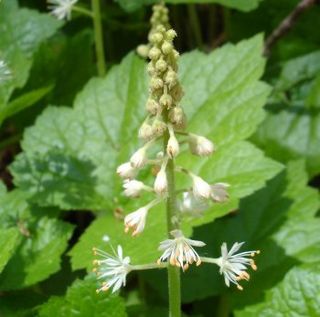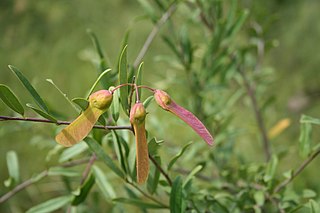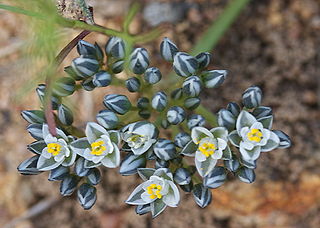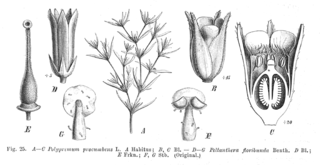
The Francoaceae are a small family of flowering plants in the order Geraniales, including the genera Francoa, commonly known as bridal wreaths. The Francoaceae are recognized as a family under various classification schemes. Under the 2009 APG III system the Francoaceae were included within the Melianthaceae. In the 2016 APG IV system the Francoaceae are again recognized as a family, with Melianthaceae included in the circumscription of Francoaceae.

The Zygophyllales are an order of dicotyledonous plants, comprising the following two families:

Saxifragaceae is a family of herbaceous perennial flowering plants, within the core eudicot order Saxifragales. The taxonomy of the family has been greatly revised and the scope much reduced in the era of molecular phylogenetic analysis. The family is divided into ten clades, with about 640 known species in about 35 accepted genera. About half of these consist of a single species, but about 400 of the species are in the type genus Saxifraga. The family is predominantly distributed in the northern hemisphere, but also in the Andes in South America.

The Polygalaceae or the milkwort family are made up of flowering plants in the order Fabales. They have a near-cosmopolitan range, with about 27 genera and ca. 900 known species of herbs, shrubs and trees. Over half of the species are in one genus, Polygala, the milkworts.

Pentaphragma is a genus of flowering plants. Pentaphragma is the sole genus in Pentaphragmataceae, a family in the order Asterales. These species are fleshy herbs, with asymmetrical leaf blades. They are found in Southeast Asia. Pentaphragma is rayless, but eventually develops rays in at least one of the species studied. This is interpreted as related to secondary woodiness or upright habit within a predominantly herbaceous phylad. The vessel elements of Pentaphragma have features universally interpreted as primitive in dicotyledons: scalariform perforation plates with numerous bars; pit membrane remnants in perforations; scalariform lateral wall pitting; the genus also has fiber-tracheids with prominently bordered pits. The presence of occasional scalariform perforation plates, often aberrant, in secondary xylem of families of Asterales sensu lato - Campanulaceae, Pentaphragmataceae, Valerianaceae, and even Asteraceae - can be attributed to paedomorphosis, extending these plates into secondary xylem from primary xylem. Raylessness in Pentaphragma can be described in terms of secondary woodiness or paedomorphosis. The fact that fiber-tracheids are shorter than vessel elements in Pentaphragma is believed related to raylessness also, because some fiber-tracheids are produced from 'potential' ray areas.
Phelline is a genus of shrubs and the sole member of the family Phellinaceae, a family of flowering plants endemic to New Caledonia. It is placed in the order Asterales and is related to two other small plant families: Alseuosmiaceae and Argophyllaceae. It contains ten species.

Boonneticae is a family of flowering plants, consisting of 4 genera and 41 species. The family is Neotropical, with the exception of the genus Ploiarium, which is found in Malesia. It is sister to the family Clusiaceae.

The Marcgraviaceae are a neotropical angiosperm family in the order Ericales. The members of the family are shrubs, woody epiphytes, and lianas, with alternate, pinnately nerved leaves. The flowers are arranged in racemes. The flowers are accompanied by modified, fleshy, saccate bracts which produce nectar. The flowers are pentamerous. The fruits are capsules.

Triuridaceae are a family of tropical and subtropical flowering plants, including nine genera with a total of approximately 55 known species. All members lack chlorophyll and are mycoheterotrophic. The heterotrophic lifestyle of these plants has resulted in a loss of xylem vessels and stomata, and a reduction of leaves to scales.

Pittosporaceae is a family of flowering plants that consists of 200–240 species of trees, shrubs, and lianas in 9 genera. Habitats range from tropical to temperate climates of the Afrotropical, Indomalayan, Oceanian, and Australasian realms. The type genus is Pittosporum Banks ex Gaertn.

Ixiolirion is a genus of flowering plants native to central and southwest Asia, first described as a genus in 1821. Recent classifications place the group in the monogeneric family Ixioliriaceae in the order Asparagales of the monocots. In earlier systems of classification, it was usually placed in the family Amaryllidaceae.

Lanaria is a monotypic genus of flowering plants containing a single species, Lanaria lanata, endemic to the southern coast of South Africa where it is associated with the fynbos belt. Lanaria lanata is commonly known as Cape edelweiss or lambtails. The genus is placed in the monotypic family Lanariaceae, a family only recently recognized by taxonomists. The APG IV system of 2016 does recognize this family.

Escalloniaceae is a family of flowering plants consisting of about 130 species in eight genera. In the APG II system it is one of eight families in the euasterids II clade (campanulids) that are unplaced as to order. More recent research has provided evidence that two of those families, Eremosynaceae and Tribelaceae, arose from within Escalloniaceae; the Angiosperm Phylogeny Website therefore merges these two families into Escalloniaceae, and also places the family alone in order Escalloniales.

Myodocarpaceae is a family of flowering plants which contains 2 genera and 15 species. The family is accepted under the APG IV system and placed in the order Apiales. In earlier systems the two genera were included among the Araliaceae.

Oncotheca is a genus of tree endemic to New Caledonia. There are two species, Oncotheca balansae and Oncotheca humboldtiana.

Embelia is a genus of climbing shrubs once placed in the family Myrsinaceae, which is now included in the Primulaceae. There are about 130 species which occur in tropical and subtropical areas across a wide range including Africa and Madagascar and from eastern Asia to the Pacific Islands as well as Australia including:
Pakaraimaea is a genus of trees in the family Cistaceae. The genus contains a single species, Pakaraimaea dipterocarpacea, from South America. It was formerly placed in subfamily Pakaraimoideae of the family Dipterocarpaceae. The species is found in the western highlands of Guyana and in adjacent Bolivar State in Venezuela. It maintains strong ectomycorrhizal associations with a wide variety of fungal species. The trees can sometimes be seen forming large stands in the western Guyanas.

Limeum is a genus of flowering plants. It includes 25 species.

Peltanthera is a genus of flowering plants containing a single species, Peltanthera floribunda. The genus was originally placed in family Loganiaceae and has since been variously placed in Buddlejaceae, Scrophulariaceae, Gesneriaceae, or in its own family Peltantheraceae. In 2016, it was considered by the Angiosperm Phylogeny Group to be unplaced in any family, but within the order Lamiales, while Christenhusz et al. in 2017 placed it in family Gesneriaceae as subfamily Peltantheroideae. The placement in Gesneriaceae was accepted by Plants of the World Online as of March 2024.

Alismatid monocots is an informal name for a group of early branching monocots, consisting of two orders, the Acorales and Alismatales. The name has also been used to refer to the Alismatales alone. Monocots are frequently treated as three informal groupings based on their branching from ancestral monocots and shared characteristics: alismatid monocots, lilioid monocots and commelinid monocots. Research at the Royal Botanical Gardens, Kew is organised into two teams I: Alismatids and Lilioids and II: Commelinids. A similar approach is taken by Judd in his Plant systematics.


















